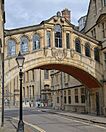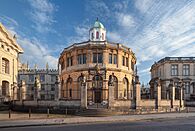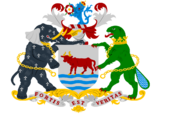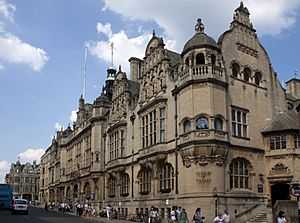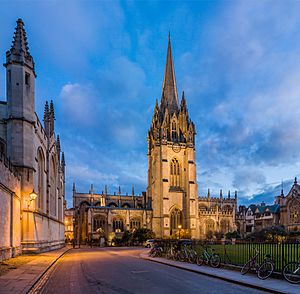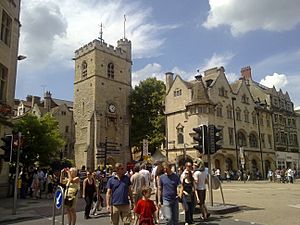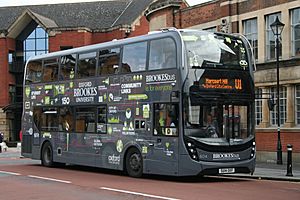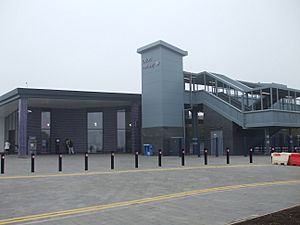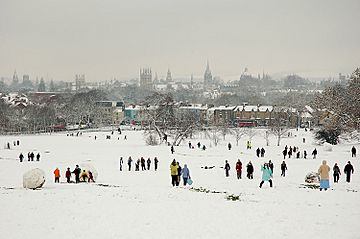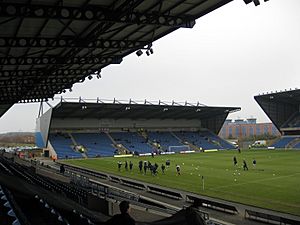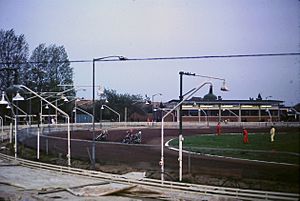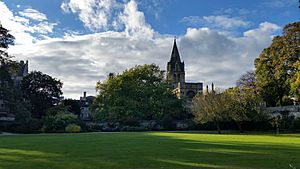Oxford facts for kids
Quick facts for kids
Oxford
|
||
|---|---|---|
|
City and non-metropolitan district
|
||
|
|
||
|
||
| Nickname(s):
City of dreaming spires
|
||
| Motto(s): | ||
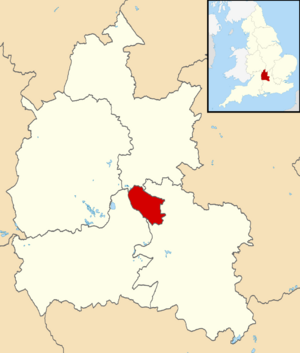
Oxford shown within Oxfordshire
|
||
| Sovereign state | United Kingdom | |
| Country | England | |
| Region | South East | |
| County | Oxfordshire | |
| Founded | 8th century | |
| City status | 1542 | |
| Administrative HQ | Oxford Town Hall | |
| Government | ||
| • Type | Non-metropolitan district | |
| • Body | Oxford City Council | |
| Area | ||
| • Total | 17.61 sq mi (45.61 km2) | |
| Area rank | 277th | |
| Population
(2005 est.)
|
||
| • Total | 152,457 | |
| • Rank | 130th | |
| Demonym(s) | Oxonian | |
| Ethnicity (2021) | ||
| • Ethnic groups |
List
|
|
| Religion (2021) | ||
| • Religion |
List
39.0% no religion
38.1% Christianity 8.7% Islam 1.6% Hinduism 0.7% Buddhism 0.7% Judaism 0.4% Sikhism 0.9% other 9.9% not stated |
|
| Time zone | UTC+0 (GMT) | |
| • Summer (DST) | UTC+1 (BST) | |
| Postcode areas |
OX1–4
|
|
| Dialling codes | 01865 | |
| GSS code | E07000178 | |
Oxford is a famous city in Oxfordshire, England. It's known as the county town. The city was founded a very long time ago, in the 8th century, and became a full city in 1542. Oxford is located where two rivers meet: the River Thames (also called the Isis) and the River Cherwell.
Today, Oxford has a population of about 152,457 people. It's about 56 miles (90 km) north-west of London. The city is home to the University of Oxford, which is the oldest university in the English-speaking world. You can see buildings from many different time periods here. Oxford is also important for making cars, publishing books, science, and technology.
| Top - 0-9 A B C D E F G H I J K L M N O P Q R S T U V W X Y Z |
History of Oxford
Oxford's story began in the Saxon period. It was an important place because it controlled the upper parts of the River Thames. The town grew even more important during the early Norman period. In the late 1100s, the University of Oxford started here. The city even faced a siege in 1142 during a time of war.

During the Middle Ages, Oxford had a notable Jewish community. Later, the university became very powerful in the town. The city was also much affected by the English Reformation, becoming the main seat for a bishop. During the English Civil War, King Charles I made Oxford his base.
In the 1800s, Oxford started to grow with industries. In the early 1900s, it had a big boom in printing and car manufacturing. These industries became less important in the 1970s and 1980s. This left Oxford as a city much larger than just a university town.
Geography of Oxford
Where is Oxford Located?
Oxford is located at 51°45′07″N 1°15′28″W / 51.75194°N 1.25778°W. It's about 24 miles (39 km) north-west of Reading. The Cherwell and Thames rivers flow through Oxford. They meet south of the city centre. These rivers and their floodplains help shape the size of the city.
Oxford's Climate and Weather
Oxford has a mild, wet climate, like much of Britain. It gets rain throughout the year, mostly from weather systems coming from the Atlantic Ocean. The coldest temperature ever recorded was -17.8°C in December 1860. The hottest was 38.1°C in July 2022.
The Radcliffe Meteorological Station in Oxford has the longest continuous weather records in Britain. These records go all the way back to January 1815. The driest year was 1788, and the wettest was 2012.
Exploring Oxford's Districts
The City Centre
Oxford's city centre is quite small. It's focused around Carfax, a crossroads. From here, you can find Cornmarket Street and Queen Street. These streets have many shops, both big chain stores and smaller local ones.
St Aldate's has fewer shops but is home to important government buildings. These include the Town Hall and the city police station. The High Street is the longest of the four streets. It has unique shops and many university buildings. Because of its historic buildings, this area is often used for filming movies and TV shows.
Oxford's Suburbs and Neighborhoods
Beyond the city centre, Oxford has many different suburbs. Some of these include:
- Barton
- Blackbird Leys
- Cowley
- Headington
- Jericho
- North Oxford
- Summertown
- Wolvercote
Oxford's Green Belt Areas
Oxford is surrounded by a special area called the Oxford Green Belt. This policy helps stop the city from spreading too much. It also protects the countryside around Oxford. While most of this green area is outside the city, some parks and meadows within Oxford are part of it. These include the University Parks and Port Meadow.
 |
Worcester | Banbury | Bicester, Milton Keynes |  |
| Witney, Cheltenham | High Wycombe, Aylesbury | |||
| Wantage, Swindon | Abingdon, Didcot, Newbury, Reading | Slough, Windsor |
How Oxford is Governed
Oxford has two main levels of local government. These are the Oxford City Council and the Oxfordshire County Council. The City Council meets at the Town Hall. This building was finished in 1897. It stands on a site that has been used for city meetings since the 1200s.
Oxford's Economy and Industries
Oxford's economy is quite diverse. It includes manufacturing, publishing, and science-based businesses. Education, sports, entertainment, and tourism are also very important.
Car Manufacturing in Oxford
Oxford has been a key place for making cars since 1910. That's when Morris Motors started here. Today, the main factory for Mini cars is in Cowley, an Oxford suburb. BMW owns this factory. It has made cars under different brands over the years.
Publishing Industry
Oxford University Press is a big part of the University of Oxford. It's based in the city. Oxford is also home to the UK offices of other large publishing companies like Wiley-Blackwell and Elsevier.
Science and Technology
The university has helped many science and technology companies start up in Oxford. Examples include Oxford Instruments and Sophos. The Oxford Science Park opened in 1990. There's also the Begbroke Science Park north of the city. Oxford is becoming known as a centre for digital innovation.
Education as an Industry

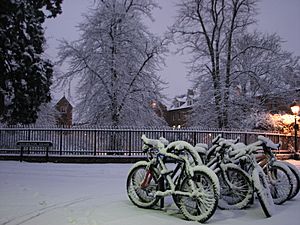
Because of its famous university, Oxford is a major hub for education. Many teaching staff come from Oxford University students and graduates. The city's reputation helps attract students, especially for learning English.
Tourism in Oxford
Oxford has many popular places for tourists to visit. Many of these belong to the university and its colleges. You can climb Carfax Tower or the University Church for great views of the city's famous spires.
Many visitors enjoy shopping at the historic Covered Market. In summer, punting (a type of boating) on the Thames or Cherwell is a popular activity. Oxford also has many shops, theatres, and an ice rink.
Shopping and Retail
The city centre has two main shopping centres: the Clarendon Centre and the Westgate Oxford. The Westgate Centre was recently made much bigger. It now includes a large John Lewis department store. Blackwell's Bookshop is also famous. It claims to have the largest single room for book sales in Europe.
Brewing History
Oxford has a long history of making beer. In the 1500s, brewing was one of the most popular jobs. Many colleges even had their own breweries. Over time, larger breweries like Hall's Oxford Brewery and Morrell's became well-known. Morrell's closed in 1998, but its history is still part of the city. Oxford's first legal distillery opened in 2017.
Famous Buildings in Oxford
Oxford has many beautiful and important buildings. Here are a few:
- Christ Church Cathedral, Oxford
- The Headington Shark (a sculpture)
- Oxford University Press
- Oxford Botanic Garden
- Sheldonian Theatre
- St. Mary the Virgin Church
- Radcliffe Camera
- Oxford Oratory
- Malmaison Hotel (in a converted prison)
Parks and Nature Walks
Oxford is a very green city. It has many parks and nature walks. There are 28 nature reserves within or near the city. Some popular ones include:
- University Parks
- Mesopotamia
- South Park
- C. S. Lewis Nature Reserve
- Port Meadow
- Cutteslowe Park
Population and People
Ethnic Groups in Oxford
Oxford is a diverse city with people from many different backgrounds. In 2021, about 70.7% of the population was White. About 15.4% were Asian, and 4.7% were Black. Many people also identify as Mixed ethnicity.
Religions in Oxford
Oxford is home to people of many faiths. In 2021, about 38.1% of people identified as Christian. A large number, 39.0%, said they had no religion. Other religions like Islam, Hinduism, and Buddhism are also practiced in the city.
Getting Around Oxford
Air Travel
For air travel, Oxford is served by Oxford Airport in Kidlington. This airport is also home to pilot training centres. You can get to bigger airports like Heathrow Airport and Gatwick Airport by train from Oxford.
Buses in Oxford

Bus services in Oxford are run by companies like Oxford Bus Company and Stagecoach West. Oxford has one of the biggest "park and ride" systems in the UK. This means you can park your car outside the city and take a bus in. Many buses in Oxford are now hybrid or use other green technologies. Most buses also offer free WiFi.
Coach Services
Long-distance coaches connect Oxford to other cities. The Oxford Tube offers frequent services to London. There are also "Airline" services to Heathrow and Gatwick airports. The main bus station for these services is at Gloucester Green.
Cycling in Oxford
Oxford is a great city for cycling. It has the second highest percentage of people cycling to work in England and Wales.
Train Travel
Oxford railway station is just west of the city centre. You can catch trains to London Paddington, Birmingham, and other places. A newer station, Oxford Parkway, is also available outside the city. Oxford is a key junction for train lines, including the planned East West Rail line.
River and Canal Transport
Historically, Oxford was an important port on the River Thames. The Oxford Canal was built to connect Oxford with the Midlands. Today, these waterways are mostly used for fun, like boating. You can take boat trips from Folly Bridge downstream.
Roads Around Oxford
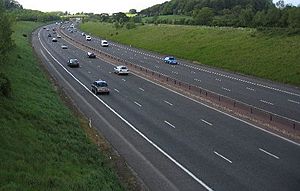
Oxford is a central point for many roads. The Oxford Ring Road goes around the city centre. It helps manage traffic. The city is also served by the M40 motorway, which connects London to Birmingham.
Zero-Emission Zone
Since February 2022, parts of Oxford city centre have a zero-emission zone. This means that petrol and diesel vehicles have to pay a daily charge to drive there. Only zero-emission vehicles can enter for free.
Bus Gates
Oxford has "bus gates" on some roads. These are short sections where only buses and other special vehicles can pass. This helps keep buses moving and reduces traffic in certain areas. More bus gates are planned for the future.
Education in Oxford
Schools in Oxford
Oxford has many schools for children of all ages. You can find a full list of schools in List of schools in Oxfordshire.
Universities and Colleges
{{Panorama|image = 1 oxford aerial panorama 2016.jpg|height= 300px|caption = Scrollable image. An aerial view of Oxford University.]]

Oxford is home to two main universities: the University of Oxford and Oxford Brookes University. Ruskin College also offers higher education. The University of Oxford is the oldest in the English-speaking world. It's one of the most respected universities globally. It's known for its unique "tutorial" teaching style.
The Bodleian Library
The University of Oxford has the largest university library system in the UK. The Bodleian Library is the second-largest library in the country. It has over 11 million books! It's a "legal deposit" library, meaning it gets a free copy of almost every book published in the UK.
Media in Oxford
Oxford has local radio stations like BBC Radio Oxford and Heart South. There are also local TV news services. For newspapers, you can read The Oxford Times (weekly) and the Oxford Mail (daily). Daily Information is a local news sheet that has been published since 1964.
Culture in Oxford
Museums and Art Galleries
Oxford has many museums and art galleries, and most are free to enter. They are popular with tourists. The Ashmolean Museum is the world's first university museum and the oldest museum in the UK. It has amazing collections of art and archaeology. These include works by famous artists like Michelangelo and Picasso.
The University Museum of Natural History has animal, insect, and rock collections. You can see skeletons of a Tyrannosaurus rex and a Triceratops there. It also has the most complete remains of a dodo bird in the world. Next to it is the Pitt Rivers Museum, which shows collections about human history and cultures.
The Museum of the History of Science is in the oldest museum building made for that purpose. It has 15,000 items showing the history of science. Other museums include Modern Art Oxford and The Story Museum.
Music Scene in Oxford
The Holywell Music Room is believed to be the oldest purpose-built music room in Europe. Many famous musicians have come from Oxford and nearby areas. The most well-known band is Radiohead. Other popular bands include Supergrass and Foals. Oxford also has several brass bands, like the City of Oxford Silver Band.
Theatres and Cinemas
Oxford has many places to watch plays and movies. Some of the theatres include:
- New Theatre
- Oxford Playhouse
- Old Fire Station Theatre
- North Wall Arts Centre
There are also several cinemas, such as:
- Curzon Cinema
- Odeon Cinema
- Phoenix Picturehouse
- Ultimate Picture Palace
Literature and Film in Oxford
Oxford has inspired many famous writers and films. The city is often called the "city of dreaming spires" because of its beautiful architecture.
Many well-known authors have lived or studied in Oxford:
- Lewis Carroll (Charles Lutwidge Dodgson), who wrote Alice's Adventures in Wonderland, was a student and teacher at Christ Church.
- C. S. Lewis, author of The Chronicles of Narnia, was a student and fellow at Magdalen College.
- J. R. R. Tolkien, who wrote The Lord of the Rings, was a student at Exeter College and later a professor at Merton College.
- Colin Dexter wrote his Inspector Morse detective novels, which are set in Oxford.
- Philip Pullman, author of the His Dark Materials trilogy, is also an Oxford resident.
Oxford has been featured in many books and movies:
- The "Harry Potter" films used many Oxford locations.
- Brideshead Revisited by Evelyn Waugh is partly set here.
- The TV series Inspector Morse, Lewis, and Endeavour are all set in Oxford.
- A Discovery of Witches and X-Men: First Class also feature Oxford.
Sports in Oxford
Football
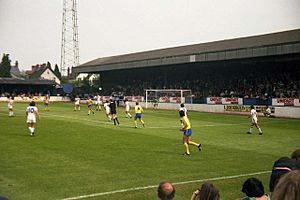
Oxford's main football team is Oxford United. They play at the Kassam Stadium. Another local team is Oxford City F.C., which is a semi-professional club.
Rowing
The Oxford University Boat Club is famous for competing in the annual Boat Race against Cambridge. Oxford Brookes University also has a strong rowing club. There are several public rowing clubs in the city too.
Cricket
Oxford University Cricket Club is very well-known. More than 300 of its players have gone on to play internationally. Oxfordshire County Cricket Club also plays in the area.
Athletics
Headington Road Runners is Oxford's main running club. It's where Olympic runner Mara Yamauchi started her career.
Rugby
Oxford has both rugby league and rugby union teams. Oxford Harlequins RFC is the city's main rugby union team. Oxford University RFC is very famous, with many players who have played internationally.
Hockey
There are several field hockey clubs in Oxford. The Oxford Hockey Club plays its home games at Oxford Brookes University.
Ice Hockey
The Oxford City Stars are Oxford's local Ice Hockey team. They play at the Oxford Ice Rink. There are teams for both adults and children. The Oxford University Ice Hockey Club has a long history, dating back to 1885.
Speedway and Greyhound Racing
The Oxford Cheetahs are a motorcycle speedway team. They have raced at Oxford Stadium in Cowley since 1939. The stadium also hosted greyhound racing until 2012.
American Football
The Oxford Saints are Oxford's senior American Football team. They have been competing against other British teams for over 40 years.
Gaelic Football
Éire Óg Oxford is Oxford's local Gaelic Football team. It was started by Irish immigrants in 1959.
Religion in Oxford
Oxford has many places of worship for different religions. These include:
- Oxford Central Mosque
- Christ Church Cathedral, Oxford
- University Church of St Mary the Virgin
Oxford's International Connections
Oxford is twinned with several cities around the world. This means they have special friendly relationships. Some of Oxford's twin cities include:
- Bonn, Germany
- Grenoble, France
- Leiden, Netherlands
- León, Nicaragua
- Ramallah, Palestine
- Wrocław, Poland
- Padua, Italy
Freedom of the City
The "Freedom of the City" is a special honour given to people or military units. It means they are recognized for their great service or connection to Oxford. Some famous people who have received this honour include:
- Vice Admiral Horatio Nelson, 1st Viscount Nelson
- William Morris, 1st Viscount Nuffield
- Nelson Mandela
- Colin Dexter (the author)
- Roger Bannister (the athlete)
- Philip Pullman (the author)
See also
 In Spanish: Oxford para niños
In Spanish: Oxford para niños



